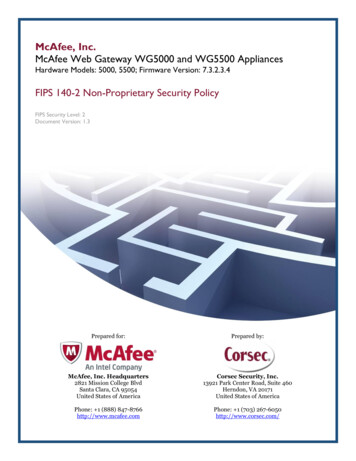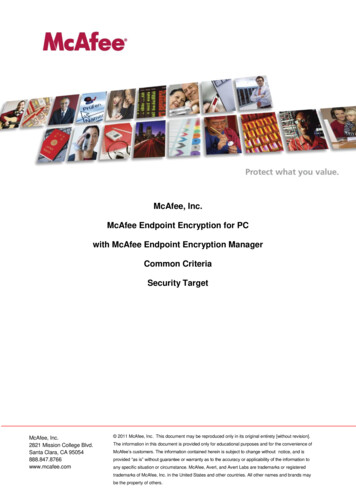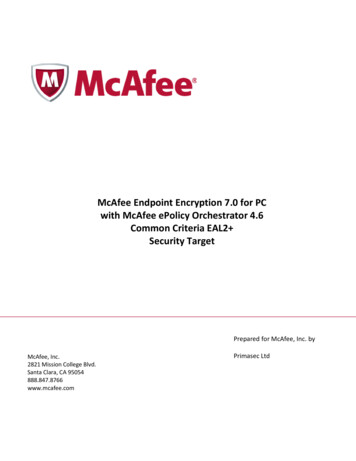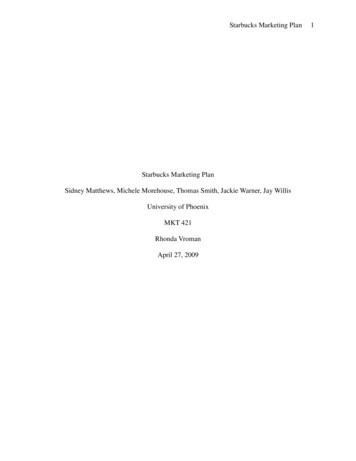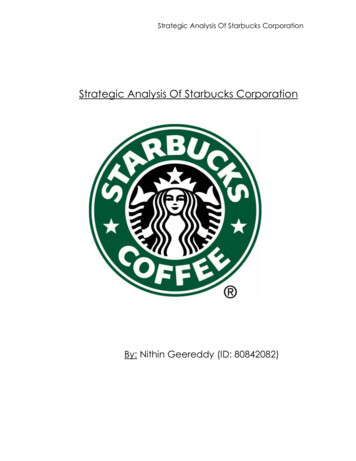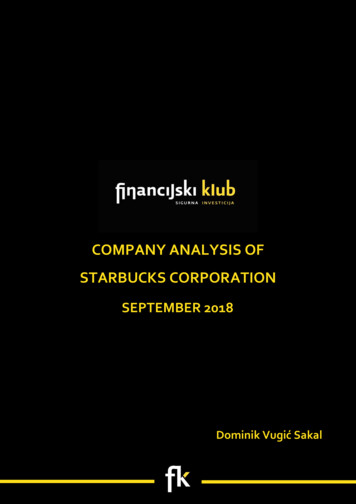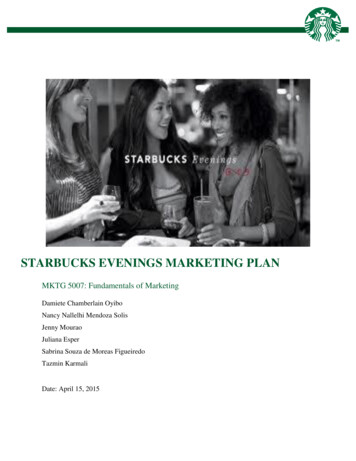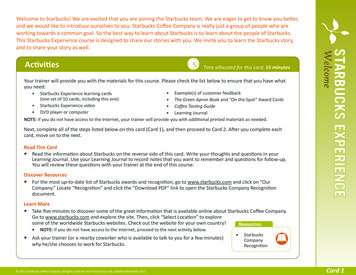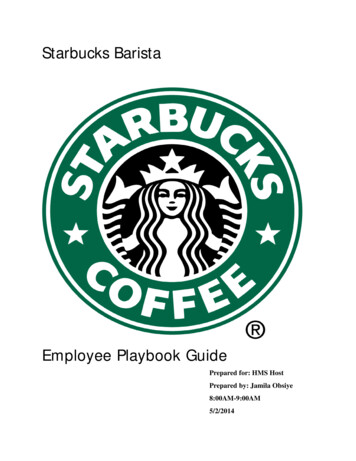
Transcription
The Future of StarbucksAn Analysis by Team Macchiato:Zack HigbeeChen Yee LiawCalvin TingKevin TjhoMichelle Ton1
Executive SummaryStarbucks Corporation has arguably been the most successful coffee chain in the past few decades,using their aggressive expansion strategies to push out much of its competition. Through itsexpansion, Starbucks has focused on creating a dense network of stores all around America, whilealso opening up new locations all around the world. By leading the retail coffee market, Starbucksis able to sell its coffee for a premium price and increase their profitability. Its success can be seenin the gradual rise of its stock prices from 1992 – 2007, reaching almost 6000% of their initialpublic offering 1 .Yet, in the recent year, the market has shown Starbucks to be in constant decline, as their stockhas dropped about 15/share, a value they have been above since 2004. Also, looking atStarbucks’ SEC filings, we can see that its comparable store sales have decreased significantly in USmarkets since 2004. This has prompted Team Macchiato to evaluate Starbucks’ current strategiesin addition to the retail coffee market as a whole. To evaluate the problem, one of the biggestquestions to consider is to what extent is the “designer coffee” market just a fad. In other words,will the allure of gourmet Starbucks coffee be maintained or will more appealing options threatenthe success of Starbucks’ primary product? If the designer coffee market is indeed a fad industry,we need to evaluate Starbucks’ possible options to avoid further decline.Problem DefinitionThe overarching question that we should answer is how Starbucks can stay profitable in the future.A good place to start involves evaluating the current market for coffee; from this point, we cangather information about market performance and determine the extent to which designer coffeeappeals to current consumers. Through market analysis, we can investigate whether or not thedemand for gourmet coffee is wavering. We will evaluate whether coffee companies in generalare having trouble maintaining profitability or if it is just Starbucks that has declined in recenttimes. If the market is indeed in decline, we must answer the following questions:‐If designer coffee is just a fad, is the temporary popularity approaching the end or has the fadalready ended?‐What are the options available to companies like Starbucks that specialize in fad coffeeproducts?Afterwards, it is necessary to analyze Starbucks’s strengths, weaknesses, opportunities, andthreats. From this analysis, we can determine Starbucks’s motivations behind their current1www.finance.yahoo.com, SBUX.2
business strategies. Also, what strategies should Starbucks pursue in the future in order to avoidfurther decline and how can Starbucks counteract efforts from competitors?The Current SituationCompared to the rest of the market, during the past year Starbucks’ stock has steadily declined invalue. Meanwhile, Peet’s Coffee, one of Starbucks’ major competitors, has had its stocks performabout the same as the rest of the market, following the general trend of rises and drops that themarket experienced.Since May of 2007, Peet’s stock has remained steady, peaking in December 2007 at 30 dollars ashare, and reaching a low of 20 dollar a share in the middle of March 2008. Meanwhile, Starbuckshas been on a steady decline, its stocks dropping by 50% of their value since May of 2007, fromabout 30 dollars a share down to 16 dollars a share. The last time Starbucks stock was tradedabove 20 dollars a share was at the end of January 2008. In comparison, in the past year, thelowest Peet’s stock has been was 19.89 a share.Considering other minor competitors who have been encroaching on Starbucks’s coffee business,both McDonald’s and Burger King have been outperforming the market in the past year. Last year,Consumer Report rated McDonald’s coffee above Starbucks coffee for the first time.Another important financial aspect to evaluate is Starbucks’ comparable store sales, or thepercentage of revenue growth among their existing stores. Since Starbucks’ primary strategy is toexpand at a much higher rate than its competitors, it is much more useful to get a sense of howStarbucks’ existing coffee stores are performing, rather than including their newly expandedlocations. A glance at Starbucks’ SEC Filing for the fiscal year of 2007 reveals that Starbucks’annual comparable store sales growth has steadily decreased from 11% in 2004 to 4% in 2007 inUS markets 2 . In February of 2008, Starbucks reported that its comparable store sales contracted1%, due to 2% increase in the average value per transaction offset by a 3% decrease in the numberof transactions 3 . Though their international comparable store sales growth has consistentlyremained around 7‐8%, their overall consolidated same‐store sales growth has decreased from10% in 2004 to 5% in 2007. This dramatic decrease in growth may be financial evidence thatStarbucks’ performance as a specialty coffee chain is waning.When comparing net revenue growth instead, Peet’s and Starbucks both have shown a relativelyconsistent percentage for the past three years (18 – 20%) 4 . Additionally, in Starbucks’ most recent2Starbucks 10‐K Filed 11/29/2007 (SEC Website)3Starbucks 10‐Q Filed 2/8/2008 (SEC Website)4Starbucks 10‐K Filed 11/29/2007 (SEC Website)3
quarterly performance report, they mentioned that they will no longer be announcing their samestore sales growth. Their reasoning stems from “ near term changes that will significantly impactthe Company's U.S. retail stores [and comparable store sales metrics] will not be an effectiveindicator of the Company's performance 5 .” Removal of this information from the public eye isindicative of an unhealthy downturn in Starbucks’ expected performance.Problem AnalysisAs of late, Starbucks has clearly been declining compared to its main competitors and compared tothe market. One cause of this may be the current economic downturn. The slowdown in theeconomy has changed people’s spending habits. According to the Associated Press, “Research byWSL Strategic Retail found that premium brands or food and specialty coffees are [among] thetop areas where people are trimming their spending.” 6Starbucks considers itself a premium coffee provider, as is evident from the statement from TheEconomist “Howard Schultz once said that he finds it painful when people compare his firm,Starbucks, to McDonald's. The founder of the world's biggest chain of coffee shops thinks a visit toStarbucks should involve “romance and theatre”, a far cry from the pit‐stop‐like experience ofeating a meal at the world's biggest fast‐food chain.” 7According to The Economist, “Not all of Starbucks' poor performance is of its own making. Pricesfor food commodities are at all‐time highs, prompting the firm to increase prices twice in the pastyear. This has scared off customers, who have been defecting to fast‐food chains such as Dunkin'Donuts or Panera Bread, which sell reasonable coffee for as little as a quarter of the price of afancy Starbucks brew.”7Meanwhile, on one front, Starbucks has continued to embrace this legacy of unique excellenceand high quality coffee. According to USAToday, Schultz “ says the company is having success inBoston and Seattle testing a premium coffee that sells for 2.50 per cup, about a buck more than asimilar cup of the regular drip coffee. ‘We're going to go up in experience — not down,’ he says.” 8Facing competition from McDonalds and Dunking Donuts, Starbucks experimented with 1bottomless 8oz. cups of coffee for a short time in Seattle. However, Schultz “ axed a test of dollarcups of coffee in Seattle”8. In addition, he’s specifically stated "We're not in the fast‐foodbusiness."85Starbucks 10‐Q Filed 2/8/2008 (SEC omy/doing ness/displaystory.cfm?story id food/2008‐03‐18‐starbucks‐changes N.htm4
Thus, as we can see, Starbucks is committed to remaining in the premium coffee and premiumservice industry. Though their slowdown is partially caused by the market, it is clear that othercompetitors have not been affected as badly, so internal strategy may be the cause for theirdecline. Their strategy of not stooping down to the level of a fast food provider, for example, maybe hurting them during this economic downturn.Analysis of Starbucks Using Porter’s Five Forces1.The Threat of SubstitutionSubstitutes (Products)‐ Other beverages apart from Starbucks coffee and tea – Examples include soda, fruit juice,smoothies, water, beer and other alcoholic drinks‐ Other “quick‐grab” foods apart from pastries, muffins, doughnuts, etc sold at Starbucks.Examples include burgers, burritos, tacos, sushi, snack foodSubstitutes (Environment/Ambience)‐ Lower‐end or “less luxurious” coffee places‐ Places that offer people a place to hang out, chat, relax or even work. Examples include teahouses, fast food places, ice‐cream parlors, side‐walk cafes, and bars and pubs2.The Threat of New Entry‐ The entry barrier for the coffee industry is relatively low, even for premium coffee like Starbucks.Any large and well‐funded company where capital is not a problem could be potential entrants.‐ Some of the more current and ongoing threats of new entrants include fast food chains such asMcDonalds, Burger King and Dunkin Donuts.3.Competitive Rivalry‐ Other coffee chains. Examples include Coffee Bean & Tea Leaf, Gloria Jeans Coffee, Peet’s, andSan Francisco Coffee House‐ Smaller privately owned coffee houses‐ Secondary coffee providers. Examples include McDonalds, Burger King, Dunkin Donuts5
4.The Bargaining Power of Suppliers‐ Not much bargaining power for coffee bean suppliers due to the importance of Starbucks’business to any individual supplier, and the fact that Starbucks probably accounts for a largepercentage of any individual supplier’s sales. This gives Starbucks the ability to dictate the price ofcoffee bean sales.‐ Similarly, suppliers of paper and plastic products, such as cups, napkins, lids, etc, have very littlebargaining power due to the large amount of alternative sources Starbucks could draw from. Inaddition, Starbucks has formed contracts with such suppliers, giving them effectively no bargainingpower.‐ There is more bargaining power for suppliers of technological innovations such as automatedcoffee machines, latte and espresso machines, etc because there are not as many suppliers forsuch equipment as there are for coffee beans.5.The Bargaining Power of Buyers‐ In the past, buyers did not really have bargaining power when it came to premium coffee such asStarbucks. The sheer scale of Starbucks’ business reduces the bargaining power of any single groupof buyers.‐ With newer entrants and competitors such as McDonalds who claim to offer premium roastcoffee of reasonable quality for lower price, buyers now have slightly more bargaining power thanthey’ve had in the past.SWOT AnalysisLooking into Starbucks specifically, we need to analyze how it performs as a company and whetheror not it will continue to perform. In order to gauge this performance we look at both thecompany’s characteristics and those of the surrounding market and see what needs to be done forthe future. An excellent tool for gauging these qualities is Strengths, Weaknesses, Opportunities,and Threats analysis, also known as SWOT analysis. Considering the strengths of Starbucks:Strengths:Pretty much everyone, at least within the US, knows the name Starbucks and associates it withhigh‐end coffees. In addition, people see Starbucks as the biggest and best in the business. This is asignificant strength because Starbucks has a natural edge over its lesser‐known competitors in thatpeople already associate it with a high quality and popular experience.The enormous number of Starbucks locations allows them to reach almost every domestic marketas well as a good number of international ones. This allows them to implement new productsquickly across a large demographic and ensures a large exposure of clientele to prevent new6
entrants from gaining market share. Additionally, taking advantage of existing establishments suchas Barnes and Noble and opening smaller cafés in other businesses allows them to expand theirmarket while keeping costs low. This also allows them expand their marketing potential todifferent demographics.While their business isn’t as well established internationally as a company like McDonalds, there isan extremely large benefit to having a globalized business (see Appendix). Aside from the obviousscale advantages, being international also helps to prevent the rise of international competitorsthat may build up enough capital to jump into the American market.Starbucks has a well‐known practice to make efforts to preserve the environment and be ethical inits dealings. This gives the company a good public image, which serves to counter some criticismthat its sheer size creates. Its size also helps its position in the market. Being ahead of all itscompetitors in the industry in terms of size and volume allows them to set the prices and preventthe growth of other companies.Starbucks successfully changed the public opinion of coffee products from a commodity to a luxurygood, and in so doing, enabled an increase in price for these goods to a much higher level thanwould have been possible before.Starbucks’ mission to make its stores a “third place” for people to go besides work and homecomes by offering services like free internet and comfortable chairs. This goal gives Starbucks theambiance to go along with its product. While Starbucks has an exceptional edge in the coffeeindustry, it has some weaknesses that may leave it vulnerable to changes in the market.Weaknesses:While most people consider Starbucks coffee a luxury good and would pay whatever price is
Starbucks’ existing coffee stores are performing, rather than including their newly expanded locations. A glance at Starbucks’ SEC Filing for the fiscal year of 2007 reveals that Starbucks’ annual comparable store sales growth has steadily decreased from 11% in 2004 to 4% in 2007 in US markets. 2. In February of 2008, Starbucks reported .
